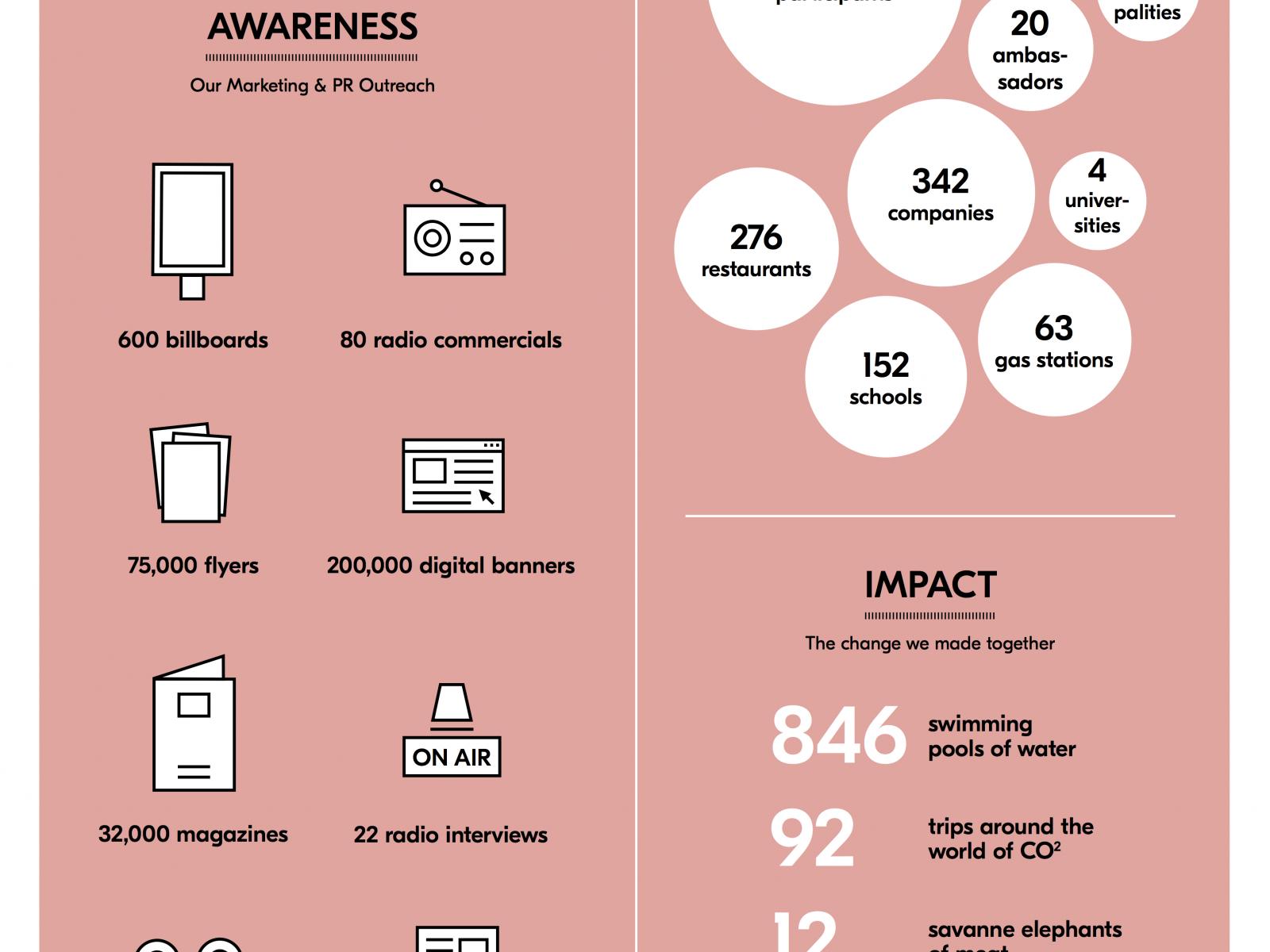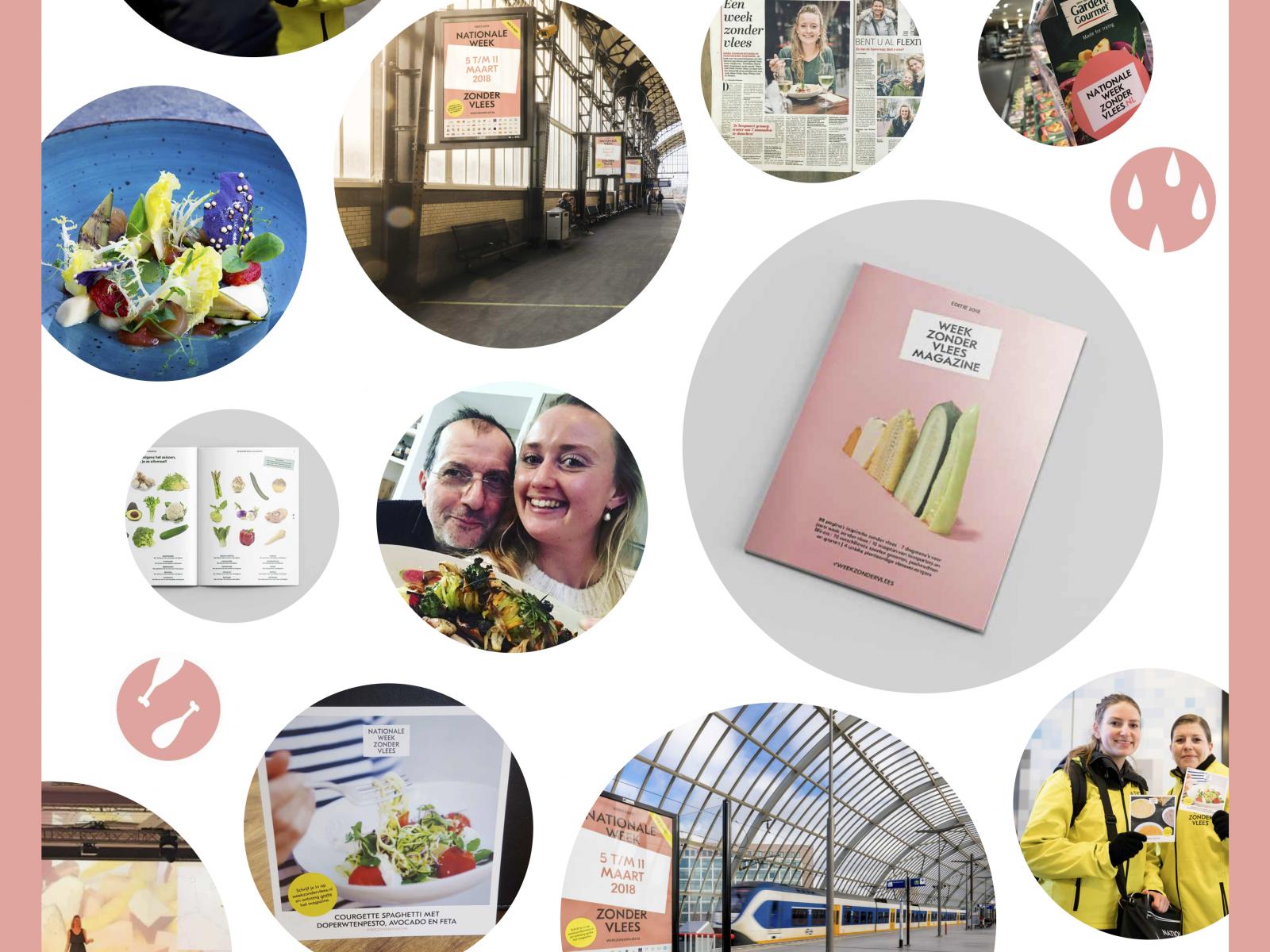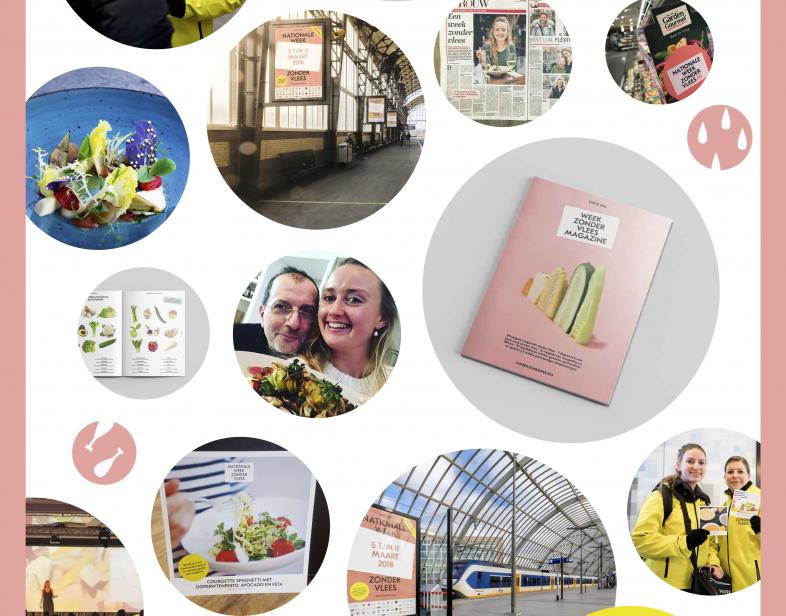An Overview Of Our Solution
Meat consumption has a heavy impact on the environment. It causes high amounts of CO2 emissions, water usage, land usage and animal harm. The solution can be found at the end of our fork, we can make a change today.
These two insights: low threshold, large impact, inspired me – a concerned vegetarian citizen – to launch a strong behavioral intervention campaign in the Netherlands: the National Week Without Meat.
The campaign was designed to make Dutch citizens aware of the positive impact of eating less meat, to change their attitude and stimulate behavioral change.
The National Week Without Meat (first edition: 5-11 March 2018) became a nation wide campaign with 32,000 participating citizens, strongly supported by the food industry, as well as the government, schools, and the hospitality sector.
- Population Impacted: 32,000 registred participants + 270,339,933 views
- Continent: Europe
Context Analysis
In 2015, the Dutch government has signed a Convention on Climate Change, striving towards 49% CO2 reduction in 2030. So far, nothing has happened. Multiple Dutch Advisory Boards and Health Organizations call out for an urgent change.
A tangible solution for this problem is situated at the end of our forks. Eating 200 grams of (mixed) meat is equivalent to 1740 grams of CO2 emissions (= 16.3 kilometers of car driving). If we reduce our meat consumption, we can make a positive difference for climate change.
Since the tradition of eating meat is so anchored in Dutch eating culture, it is hard to change. Therefore, for this behavioral intervention, we are not targeting the diehard meat consumers, nor the vegetarians, rather the meat eaters susceptible for change. This is operationalized as Dutch consumers (20-80 years old) eating meat between 3-5 times per week. The estimated size of this target group is 9 million people.
Describe the technical solution you wanted the target audience to adopt
Not willing to wait for government or corporate solutions, and with the urge to start changing people’s eating behavior today, the National Week Without Meat campaign was initiated. It was designed as a mass media campaign, to reach as many Dutch citizens as possible.
The goal of the campaign was threefold:
1. To create awareness of the positive impact of eating less meat.
2. To enable a shift in attitude towards eating meat: from difficult and tasteless to easy, tasteful and without concessions.
3. To stimulate a behavioral change by challenging participants to try this eating pattern for one week and by enabling them to discover meatless recipes and products.
In the end, the idea is that when people discover how easy it is to eat without meat during one week, their negatively biased opinions on vegetarian meals will diminish, ensuring that they will skip meat in their weekly diet more often – and incrementally increasing – once the week was finished.
Type of intervention
Describe your behavioral intervention
To change the meat-eating behavior of Dutch citizens, people were encouraged to nationally engage in one week of meat free consumption, including the following behavioral interventions:
• Eating meat is considered habitual behavior, meaning it is one of the hardest types of behavior to change. The campaign was designed to lower the threshold of eating meatless, by offering inspiration via the free magazine, and by cooperating with food industry leaders and retailers to provide discounts on vegetarian products.
• Peer pressure was considered an important behavioral factor, since eating is something people do together. Therefore, the national scope of the campaign was underlined in the messaging, also the campaign spotlighted other (famous) people as inspiring examples, lastly people were able to enroll in the weekly program as group (e.g. family/companies/teams).
• Biased attitude is a difficult one. The intervention tapped into the negative perception of vegetarian meals by offering recipe inspiration, and examples of ready-to-eat tasty veggie meals offered by food companies, restaurants, company canteens, municipality canteens, caterers and gas stations.
• Personal relevance is the last one. Although many people read about climate change and the relation with the meat industry, they don’t feel their behavior can make a difference. Therefore the intervention included a strong and tangible visualization of how many CO2 and water one person can save.
As needed, please explain the type of intervention in more detail
The design of the intervention was not solely focused directly on consumers. The food industry was considered an essential part in the success of this intervention. They ensured that consumers were not only approached through the (multi-media) means of the campaign directly, but also through other channels, ensuring multiple touchpoints. This included the following:
- 9 retailers offered discounts on vegetarian products
- 47 food producers and brands openly offered their support, as well financially as via their communications channels
- 152 elementary schools and high schools offered an interactive class on vegetarian cooking
- 353 university canteens, company canteens, municipality canteens and caterers offered an extensive vegetarian menu
- 276 restaurants, from simple bars to fine dining establishments, offered a special vegetarian menu, reduced in cost
- 63 gas stations offered vegetarian snacks
- 22 ambassadors (athletes, chefs, famous people) actively participated in their social channels.
Describe your implementation
The campaign consisted of the following carefully selected elements to impact people’s eating behavior:
• A concerned citizen, also known as a vegetarian influencer, introduced the campaign - clearly without any political or commercial interests.
• A collective funding model, having 56 renowned partners from the food industry sponsoring the campaign financially and spreading the message to their fan bases.
• Carefully designed messaging, focusing on two pillars:
1) the environmental savings caused by eating less meat, expressed in tangible terms.
2) tasteful and practical recipe inspiration for all day meals without meat.
• Multimedia campaign to recruit participants by a strong mix of online and offline outlets, paid and free publicity, owned channels and partners channels. Including 600 billboards, 80 radio commercials, 75,000 flyers, 200,000 digital ads, 22 radio items, 12 tv items and 367 articles.
• Incentive for enrollment: every participant who registered on the website got a personal copy of the Week Without Meat-magazine, functioning as their personal guide for a successful week without meat.
• Engagement of the society by connecting retailers, schools, universities, restaurants, canteens, caterers, gas stations and ambassadors (athletes, chefs, famous people).
The first edition of 2018 was a great success, ensuring the yearly recurrence of the campaign. For the 2019 edition, the campaign will be improved on three key learnings:
• In 2018, Isabel Boerdam designed, operationalized and managed the campaign for 80% on her own. In 2019, budget will be made available to build a powerful team ensuring an optimal execution.
• Now the campaign has proven its relevance and success, a goal is to engage high-profile stakeholders in politics and the Royal House.
• For 2019, the campaign will be strengthened by focusing on the measurability of the results in term of attitude and behaviour change, as well short term and long term.
External connections
The campaign was initiated by one concerned citizen: Isabel Boerdam. Isabel is a known and trusted promoter of a vegetarian lifestyle and therefore a credible initiator of the campaign. She was a key success factor.
Another success factor was the stakeholder management connecting many sectors and companies to the campaign:
• RETAILERS like Albert Heijn, Aldi and Coop supported the campaign, spotlighting and discounting their wide range of vegetarian products.
• FOOD COMPANIES: meat replacing brands like Garden Gourmet and Quorn, legume brands like Hak and Bonduelle, food brands like Maggi, Becel and GranItalia, and fresh vegetable brands supported the campaign by spotlighting their plantbased product portfolio and engaging their fan bases.
• SCHOOLS: elementary and high schools received a ‘Week Without Meat presentation package’ enabling them to address the topic during class.
• RESTAURANTS: hundreds of restaurants promoted their vegetarian menu and offered the participants special eating out options.
• COMPANY CATERERS: all well known caterers received a promotional display package to showcase their support. Sodexo, one of the biggest Dutch catering companies, participated with over 160 locations.
• GAS STATIONS: Shell expanded their vegetarian snack offering in all Deli2Go shops on 60+ high ways.
• AMBASSADORS: vegetarian and flexitarian athletes, chefs and famous people became ambassadors by sharing their support and tips via social media.
Who adopted the desired behaviors and to what degree?
32,000 participants officially registered via the website and dedicated themselves to not eating meat for 7 days. Many of them (uncounted) informed us during the week how positively surprised they were by the taste and comfort of vegetarian eating. They confirmed that they would be happy to continue doing it. These diaries of some of the participants give a great impression of their experiences during the week: https://weekzondervlees.nl/dagboeken-van-deelnemers/.
Additionally, we engaged:
• 56 food industry partners
• 276 restaurants
• 342 companies and their canteens
• 152 schools
• 63 gas stations
• 4 universities and their canteens
• 7 municipalities
Lasty, with our multimedia campaign (media, PR, social media), we reached 270,339,933 views, which is incredible for a country of 17 million people.
Next year, we will ensure proper measurement of the short term and long term impact on attitude and behaviour change.
How did you impact natural resource use and greenhouse gas emissions?
During the National Week Without Meat, we made an environmental difference and impacted the climate in a positive way. Together we saved:
• 330,624,000 liters of water (846 swimming pools)
• 389,760 kilos CO2 emissions (92 trips around the world)
• 44,800 kilos meat (12 savanne elephants)
However, the biggest impact was believed to be more structural. All participants experienced what it was like to eat meatless for one week. This makes it easier for them in the future to incorporate vegetarian meals into their lifestyle on a structural basis.
What were some of the resulting co-benefits?
During the National Week Without Meat, the Dutch supermarkets sold 1,1 million euro less meat, and the same amount of extra vegetarian products. So we can actually speak of the beginning of a behavioral change: consumers truly discovered new products and tastes, and we can trust that a part of them will become regular users of vegetarian products.
Sustainability
The campaign started without funds. The campaign was funded by 56 food companies all donating the reasonable amount of 2000-3000 euro (and some a bit extra), in exchange for some exposure for their brand and product. This appeared to be a great funding model, since the amount is relatively small for the food companies and at the same time the campaign really steps into their social and sustainable goals. Conclusion: the campaign is economically very sustainable.
Return on investment
The campaign was funded with 133,000 euro, mainly invested in 600 billboards, 80 radio commercials, 75,000 flyers, 200,000 digital ads, 22 radio items, 12 tv items, 367 articles and 32,000 magazines.
These activities generated potential 159,43 million views (incredible for a country with 17 million people) and loads of awareness.
Our activities on social media gained 110,91 million views over 3 channels, and resulted in #weekzondervlees as a trending topic on Twitter on March 5.
In total this summed up to 270,339,933 views of our important message. The best return on investment you can imagine.
Currently there is 5000 euro left to kick start the 2019 edition. This is all we can hope for, since it is a non-profit campaign.
How could we successfully replicate this solution elsewhere?
The campaign is perfectly internationally replicable with the following ingredients:
• A concerned citizen (preferably influencer) as the hero, spokes person and face of the campaign
• A collective funding model by food companies, build on many small fundings like 2000-4000 euro.
• Carefully designed messaging, suiting the local sentiment and trends, focusing on two pillars: the environmental savings caused by eating less meat (preferably concrete expressed) and recipe inspiration.
• Multimedia campaign with a strong mix of online and offline outlets, paid and free publicity, owned channels and partners channels.
• Incentive for enrollment: e.g. the National Week Without Meat-magazine.
• Engagement of the society by connecting retailers, elementary schools, high schools, universities, restaurants, company canteens, municipality canteens, caterers, gas stations and ambassadors (athletes, chefs, famous people).


